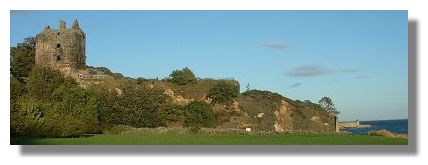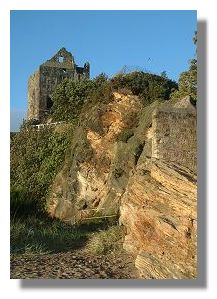Places to Visit in Scotland
- Ravenscraig Castle, Fife

History
Ravenscraig castle was planned before 1460 for Mary of Gueldres, the wife of King James II, on land which had previously been owned by the Ramsays. It is located on a promontory, high above the beach, with views across the Firth of Forth to Edinburgh. After King James II died in 1460 - when a cannon exploded during the siege of Roxburgh Castle - work appears to have continued and to have been sufficiently far advanced for Mary of Gueldres to be in residence when she died in 1463.
The layout of the castle consists of two D-shaped towers linked by a lower block of apartments. There is a deep ditch at the front and a courtyard and other buildings extend out onto the promontory, surrounded by a low wall.
Ravenscraig was one of the first castles in Scotland built to withstand cannon fire. But as a result of the very thick walls to withstand the cannon balls, the single rooms on each floor of the two towers are relatively small. It was also one of the earliest castles designed to use cannons as a defence and it had numerous gun ports in its walls.
In 1470, King James III decided to force a swap of Ravenscraig for Kirkwall Castle, which had been owned by William Sinclair in Orkney. Ravenscraig thus became the property of the Sinclair Earls of Roslin (based at Rosslyn Castle) who completed its construction. The Sinclairs occupied Ravenscraig until 1650 when it suffered damage from the guns of Cromwell's army. It then passed by marriage to the Sinclair-Erskines who owned it until 1898.
The Castle in More Modern Times
As it is located on a promontory, 70 feet above the beach, it offers some great views across the Firth of Forth. When the Danish story-teller Hans Christian Andersen visited Ravenscraig, he described it as "so picturesque and so characteristic" and the view across the Forth to Edinburgh "magnificent and unforgettable."
The long flight of steps leading down from the castle to the Pathhead Sands is said to have been the inspiration for John Buchan's novel "The Thirty-nine Steps" - though there are a lot more than 39 steps on the way down! Prester John, by the same author, opens on Pathhead Sands.
Although it is now unoccupied and somewhat ruinous (it was used as a stone quarry at one stage), there are substantial parts still standing, a testimony to its stout construction. The castle is beside a municipal park and access is via a path which is overlooked by a modern housing development, which detracts somewhat from its romantic appearance.
How to Get There

Ravenscraig Castle is on the northern edge of what is now the town of Kirkcaldy, in Ravenscraig Park off the A955 road Dysart. There appears to be no parking at the entrance to the park but there is a car park a few hundred yards before that. There is also a road from the car park down to the Pathhead Sands.For a detailed location map, see the StreetMap UK map of the area. (Note that you can access a larger scale map of the area via that Web page).
Return to Index of Places to Visit




